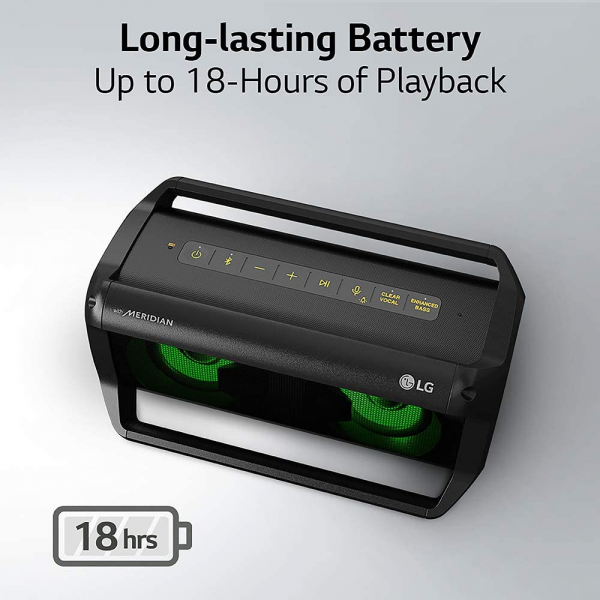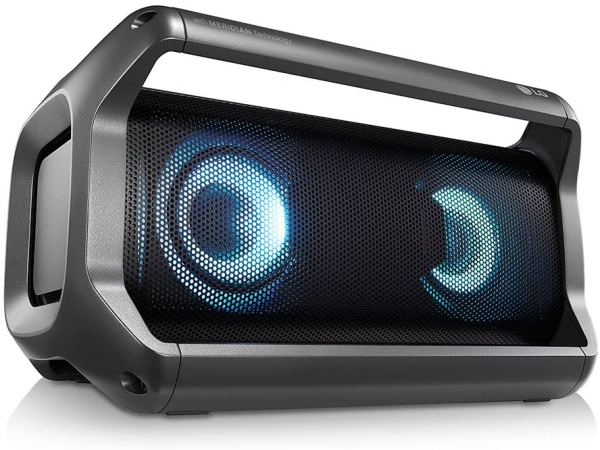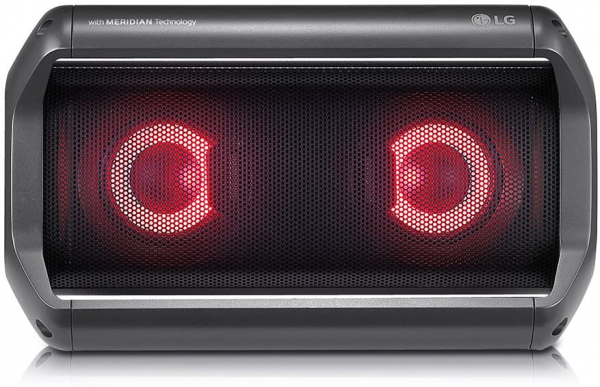LG
Nomadic speaker LG PK5: a sound performance and a template between two waters
Aprox. 99€
See specificationsWith its robust nomadic speaker PK5, LG promises nothing less than exceptional sound thanks to the partnership with Meridian Audio, energetic bass and colorful LEDs to light up your parties. Let's go straight to the American quarter hour.
Positive points
Splashproof.
Well built: robust and quality materials.
Multipoint Bluetooth connection.
Complete orders.
Hands-free kit usable.
Nice stereo scene.
Bad points
Lack of frequency balance.
Lack of precision.
Directive enclosure.
Our review
Ergonomics
The tough guy hides under robust protections guaranteeing it excellent resistance to falls and good stability on most materials thanks to its non-slip pads. Despite the visible screws (perhaps even intended to produce a "raw" effect), the assembly is mastered, the construction is reliable and the materials of good quality.
We leave the design to everyone's appreciation - you have to love this little reinforced bottle side. The enclosure is also IPX5 certified, which protects it "against water jets from all directions with a lance" - in short, it can not swim, but does not fear copious splashes.
Its dimensions (22 cm long for 13 x 12 cm) place it right on the border between two templates, but its weight slices: with 1.2 kg, the PK5 is formally more portable than portable. We can therefore say that the PK5 is one of the most compact portable speakers.
The two front speakers flash to the rhythm of the drummer's kicks, swinging between pink, purple, turquoise, indigo, sky blue, orange yellow, green and apple green depending on the bpm of the song being listened to. The brightness is not very great and the colors are quite "primary". The "spectator" therefore does not see the LEDs directly (unlike the SRS-XB30, for example), but their reflection.
The controls arranged on a soft-touch plastic strip give access to all the usual functionalities. From left to right above: power on / off (single or double short press), Bluetooth pairing (SBC, AAC, aptX and aptX HD), adjustment of listening volume and navigation between tracks (press more or less long on the + and - buttons), play / pause, call management and voice assistant (integrated in the paired smartphone), activation of the LEDs, "Clear Vocal" mode and "Enhanced Bass" mode. The buttons, large and responsive, require light pressure to obey. A battery level indicator is visible on the far left, lighting up in red when autonomy is at risk.
The hands-free kit is quite effective in a calm environment: the voice is certainly somewhat smooth, but remains completely intelligible and recognizable, and the subject matter quite understandable. The above recording was made 30 centimeters from the speaker, without specifically directing speech to the microphone of the speaker.
Speaking of autonomy, note that the promise of 15 hours is made for a listening volume of 50% and without the effects of light. At 75% of the volume and without light effects, the autonomy amounts to 12 hours. With the light effects alone, we recorded 6 hours of use, while the entire sound and light show fell to 4 hours. The PK5 is recharged by USB-C (cable supplied), and also offers an analog input in mini-jack.
Latency is 180 ms in aptX. Note that it is also possible to pair two PK5s in stereo to benefit from a wider scene, and to pair two sources simultaneously: when the two sources broadcast a signal, it is possible to switch between the two via the play / pause button. Note also that the speaker can be used during charging.

Audio
The PK5 offers a generally balanced sound performance ... in the medium range, in their widest sense (from around 200 Hz to 1.8 kHz). Contrary to the promise of the Korean manufacturer, the bass is not particularly energetic - nor deep for that matter. Their presence is however punctually accentuated around 65 Hz thanks to the action of the two passive radiators, which can effectively give the impression that there is a solid base, but in a very round and little controlled manner.
The lower mids (from 200 to 500 Hz) are the frequencies most represented, which creates a comfortable bed for the mix. Alas, precision is not required, and said frequencies do not hesitate to make the wall to cheerfully encroach on the neighboring frequency ranges. The mix of some songs very rich in tablecloths and / or effects of all kinds (we think in particular of A Drowning from How To Destroy Angels) is found devoured by the confused and "swampy" side of this frequency zone.
Despite this burial under the first part of the spectrum, the mediums are doing well and remain understandable. When the listening track is only vocal (podcasts, interviews ...), the voices are completely intelligible, with timbre acceptably transcribed. The latter, however, lack fullness, richness, because of the withdrawal of the treble: the speakers being quite directional, if one is placed in the axis, one perceives the treble, but as soon as the listener offsets (even vertically), the rendering becomes muted. The result of all these points is a rendering which, without being truly deaf, sounds slightly "cardboard", and whose acoustic spaces reproduced (through the reverberations) vary according to the listening position. Note however that the wireframe and Bluetooth renderings are absolutely identical, whether on the side of the frequency response or the harmonic distortion rate.
The power echoes the size of the speaker: the maximum volume is worthy of that of a transportable speaker, while the harmonic distortion rate rather indicates belonging to the category of portable speakers. The rendering is fairly clean up to 50% of the maximum volume, colored between 50 and 75% - beyond, the saturation becomes very audible, and the emphasis on mediums becomes all the more obvious.
Two equalization modes are available. The Clear Vocal mode accentuates the frequencies between 3 and 4 kHz, further supporting this nasal rendering: in fact, the voices are more intelligible, but the instruments with a sharp range take a flashy and garish turn - therefore to reserve for content of which only speech intelligibility matters. The Enhanced Bass mode, for its part, certainly reinforces the bump of the 70 Hz, but in no case brings more consistency to the entire bass. Let's finish with a word on the spatial reproduction of the speaker: if the diffusion is not omnidirectional, it is because LG opts here for a stereophonic rendering. The feeling of width residing in the treble and the PK5 being quite directive, it goes without saying that the scene seems wider when the listener is in front of the speakers. In this case, the stereophonic scene is surprisingly wide, nicely exceeding the dimensions of the enclosure.

Conclusion
Thanks to its robustness, its good sound power and the complete ergonomics it offers, the PK5 is a good party companion. However, the sound and light show that it deploys is far from being the best, both on the sound side and on the light side: in the same price range, we think in particular of the Libratone One Click or the MegaBoom of Ultimate Ears for acoustic performance, and JBL Pulse 3 for the different scenographic options.

Specifications

